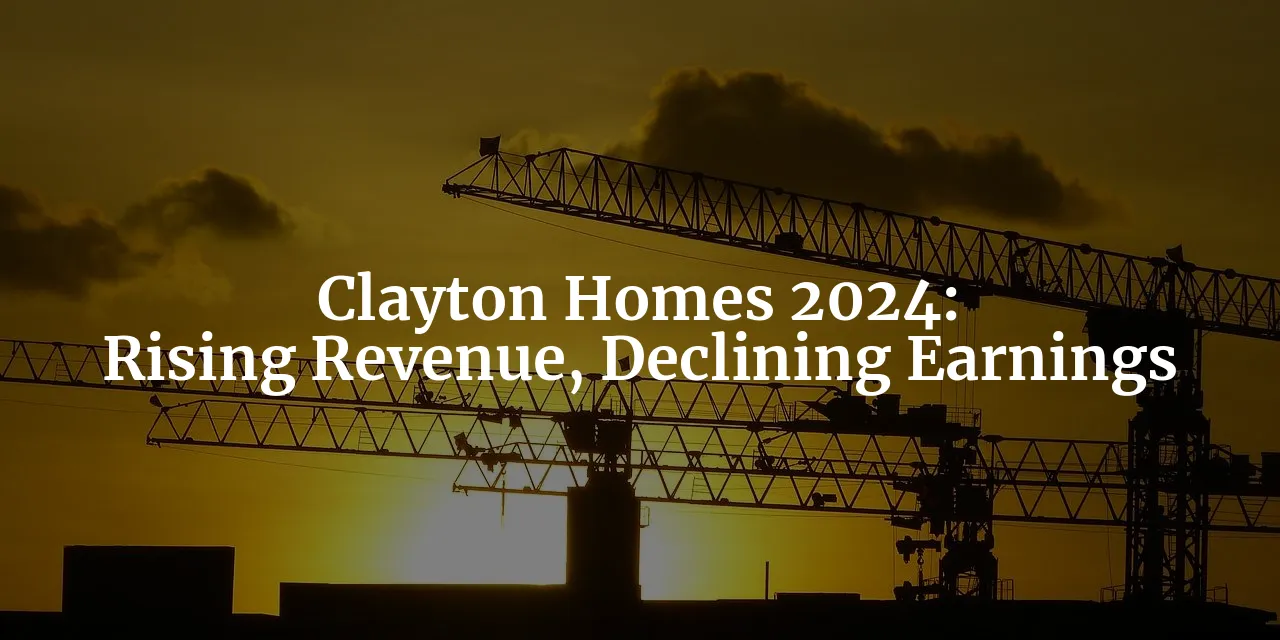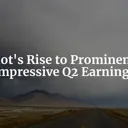Tags: Clayton Homes / Earnings
This fanpage is not officially affiliated with Berkshire Hathaway: Disclaimer
In the face of rising revenues yet declining pre-tax earnings, Clayton Homes presents a captivating case study for Berkshire Hathaway shareholders. This article uncovers the intricacies of the housing market, explores strategic sustainability initiatives, and highlights the company's resilience amidst economic challenges. Dive in to discover the future of innovative home building!

Introduction
Clayton Homes, a cornerstone of the American manufactured housing industry, has a storied history that dates back to its founding in 1956. Acquired by Berkshire Hathaway in 2003, Clayton Homes has since grown into a significant player in the housing market, known for its innovative approach to home building and financial services. This journey has been marked by resilience and adaptability, traits that are particularly crucial in the economic landscape of 2024 ↗↗.
The current economic environment presents a complex tapestry of challenges and opportunities. Interest rates are at historically high levels, with the average 30-year fixed-rate mortgage hovering around 6.5% 3. This has created a dichotomy in the housing market: existing homeowners are reluctant to move due to their low mortgage rates, while new buyers struggle with affordability ↗. Additionally, the U.S. housing market has seen a sharp decline in housing starts, dropping by 6.8% in July 2024, the steepest fall since March 2024 2.
The purpose of this article is to dissect Clayton Homes' financial performance in the first half including the second quarter of 2024, focusing on the paradox of rising revenues amidst declining pre-tax earnings. We aim to provide shareholders with a comprehensive understanding of the factors driving these trends and what they mean for the future of Clayton Homes.
In the sections that follow, we will delve into Clayton Homes' impressive revenue growth despite economic headwinds, analyze the market conditions and future outlook, and explore the reasons behind the decline in pre-tax earnings. We'll also touch upon Clayton Homes' initiatives in renewable energy and sustainability, which are becoming increasingly important in today's market.
To set the stage, consider this intriguing historical fact: the housing market's current struggles are reminiscent of the 2008 financial crisis, yet Clayton Homes has managed to navigate these turbulent waters with remarkable agility. As Warren Buffett once said, "In the business world, the rearview mirror is always clearer than the windshield." This quote encapsulates the importance of understanding past performance to navigate future challenges.
Revenue Growth Amidst Economic Challenges: Market Conditions
Despite the challenging economic conditions, Clayton Homes has demonstrated robust revenue growth in Q2 2024. Revenues increased by 8.7% to $3.1 billion in the second quarter and by 8.9% to $5.9 billion in the first six months of 2024 compared to the same periods in 20231. This growth is particularly noteworthy given the broader economic landscape, characterized by high interest rates and a sluggish housing market.
One of the key drivers of this revenue surge has been the increase in home sales. Revenues from home sales rose by 7.1%, amounting to an additional $293 million in the first half of 2024. This was primarily driven by a 11.5% rise in new home unit sales, even though the average selling prices were lower1. This indicates a strong demand for Clayton Homes' offerings, which has helped offset the impact of lower prices.
In addition to home sales, Clayton Homes' financial services sector has seen a significant boom. Financial services revenues increased by 14.6% in the first six months of 2024, driven by higher average loan balances and a slight rise in interest rates 1. This growth underscores the effectiveness of Clayton Homes' integrated business model, which combines home building with financial services to create a comprehensive value proposition for customers.
To better understand the geographical impact, consider the following table showing regional differences in housing starts 2:
| Region | Housing Starts (July 2024) | Change (%) |
|---|---|---|
| South | 640,000 | -13.6 |
| West | 263,000 | -12.0 |
| Midwest | 171,000 | -1.7 |
| Northeast | 164,000 | +42.6 |
The decline in housing starts, particularly in the South and West, poses challenges for Clayton Homes. However, the significant increase in the Northeast could present new opportunities for growth 2.
Economic indicators further highlight the market conditions. The sharp decline in U.S. housing starts by 6.8% in July 2024 to an annualized rate of 1.238 million units is the lowest level since 20202. This decline reflects broader economic uncertainties and the impact of high interest rates on housing affordability. Political decisions, such as changes in housing policies or interest rate adjustments by the Federal Reserve, could also influence the market dynamics.
The current market conditions, characterized by a high average 30-year fixed-rate mortgage of 6.46%, have made it difficult for new buyers to enter the market3. Existing homeowners, who locked in historically low rates during the COVID-19 pandemic, are also less inclined to move, further constraining market activity.
Looking ahead, projections for housing starts by the end of Q3 2024 suggest a potential recovery to 1.560 million units, with long-term projections for 2025 around 1.400 million units2. These projections provide a glimmer of hope for a market rebound, which could positively impact Clayton Homes' future performance.
While Clayton Homes has achieved impressive revenue growth amidst economic challenges, the broader market conditions and future outlook remain complex. The company's ability to navigate these dynamics will be crucial in sustaining its growth trajectory and delivering value to shareholders.
The Paradox of Declining Pre-Tax Earnings
Despite Clayton Homes' impressive revenue growth, the company faces a paradox: declining pre-tax earnings. In Q2 2024, pre-tax earnings fell by 10.0%, and the first six months of 2024 saw a 1.0% decline compared to the same period in 2023 1. This conundrum raises questions about the underlying factors affecting profitability. Since the 1.0% decline amount to $10 million, we can infer that Clayton Homes pre-tax earnings are in the order of $1.0 billion for the first half of 2024. Pre-tax earnings for the entire 2023 have been $2.0 billion 6. We can contextualize the $2.0 billion estimated 2024 pre-tax earnings by comparing them to the $1.7 billion acquisition price paid in 2003 ↗.
| Year | Clayton Homes Financial Milestone |
|---|---|
| 2003 | Berkshire's Acquisition Price: $1.7 billion |
| 2024 | Estimated Pre-Tax Earnings: $2.0 billion |
The decline in pre-tax earnings can be attributed to several key factors. One major issue is the increased costs associated with building Zero Energy Ready homes. These homes, while environmentally friendly and cost-saving for homeowners, require significant upfront investment in materials and technology, which has squeezed margins1. Additionally, higher operating expenses have further eroded profitability.
Another critical factor impacting earnings is the interest expense on borrowings from Berkshire affiliates. While these borrowings help fund Clayton Homes' loan portfolio, the corresponding interest expenses have negatively affected pre-tax earnings1. This intricate financial relationship illustrates the complexity of managing growth while maintaining profitability.
Historically, many companies have faced similar paradoxes of rising revenues but declining earnings. For instance, during the dot-com boom, numerous tech companies experienced rapid revenue growth but struggled with profitability due to high operational costs and investments in new technologies. Clayton Homes' current situation mirrors this historical trend, emphasizing the challenges of balancing growth with cost management.
To better understand the specific operational challenges Clayton Homes faced, consider the following table:
| Region | Housing Starts (July 2024) | Change (%) |
|---|---|---|
| South | 640,000 | -13.6 |
| West | 263,000 | -12.0 |
| Midwest | 171,000 | -1.7 |
| Northeast | 164,000 | +42.6 |
The broader macroeconomic environment has also played a significant role in Clayton Homes' financial performance. The Federal Reserve's interest rate policies have created a challenging landscape. Recent rate hikes have not significantly slowed the economy, raising questions about the effectiveness of traditional rate cuts in stimulating the market3. The U.S. housing market, a critical component of monetary policy transmission, remains in a state of flux. Existing homeowners are reluctant to move due to historically low mortgage rates, while new buyers struggle with affordability due to elevated rates3.
In response to these challenges, Clayton Homes' management has made several strategic decisions. Increasing borrowings from Berkshire affiliates in 2024 was one such move, aimed at better matching current installment loan balances 1 ↗ ↗. Additionally, the focus on building Zero Energy Ready homes aligns with long-term sustainability goals, despite the short-term impact on margins. These decisions reflect a balanced approach to navigating financial hurdles while positioning the company for future growth.
Renewable Energy and Sustainability Initiatives
Clayton Homes is not just navigating financial challenges; it is also leading the charge in renewable energy and sustainability. The company has made significant investments in solar energy, installing 1.94 MW of solar power at its headquarters and other facilities 4.
At its Maryville, Tennessee headquarters, Clayton Homes installed a 795-kW roof-mounted solar system, powering approximately 20% of the building and serving over 2,000 team members 4. This initiative is part of a broader strategy to reduce carbon emissions and promote sustainability.
These solar projects are estimated to prevent over 1,300 metric tons of carbon emissions annually 4. This significant reduction underscores Clayton Homes' commitment to environmental stewardship and aligns with global efforts to combat climate change.
Clayton Homes' efforts have not gone unnoticed. The company received the 2024 Leadership in Sustainability award from the Manufactured Housing Institute (MHI), recognizing its dedication to sustainable practices 5. This accolade is a testament to the company's leadership in the housing sector.
The evolution of renewable energy in the housing sector has been marked by gradual but significant advancements. Clayton Homes is at the forefront of this movement, integrating renewable energy solutions into its operations and product offerings. The company's eBuilt® homes, which meet the U.S. Department of Energy (DOE) Zero Energy Ready Home™ program specifications, are a prime example4.
The economic benefits of these sustainability initiatives are substantial. Homeowners of eBuilt® homes can save up to 50% on annual energy costs, making these homes not only environmentally friendly but also economically advantageous 4. These savings enhance the value proposition for Clayton Homes' customers and contribute to long-term financial stability.
Looking ahead, the potential long-term benefits of Clayton Homes' renewable energy investments are promising. Reduced energy costs, enhanced brand reputation, and alignment with global sustainability trends position the company for sustained growth and profitability. For shareholders, these initiatives represent a forward-thinking approach that balances environmental responsibility with economic viability.
To summarize Clayton Homes' renewable energy and sustainability initiatives, consider the following table:
| Initiative | Description | Impact |
|---|---|---|
| Solar power installation at headquarters | 795-kW roof-mounted system | Powers 20% of the building, serves 2,000 team members |
| Solar carports at Sulphur Springs and Buckeye | Provides power and keeps vehicles cool | Enhances facility sustainability |
| Ground-mounted solar panels at Bean Station and Rutledge | Powers nearly 60% of annual electricity needs | Significant reduction in carbon emissions |
| eBuilt® homes | Meets DOE Zero Energy Ready Home™ specifications | Saves homeowners up to 50% on annual energy costs |
Thus, while Clayton Homes is navigating a complex financial landscape, the company is still making significant strides in renewable energy and sustainability. These efforts not only address immediate challenges but also position the company for a sustainable and profitable future.

Conclusion
Clayton Homes has demonstrated remarkable resilience in the face of economic challenges, achieving impressive revenue growth of 8.7% in Q2 2024, even as it grapples with the paradox of declining pre-tax earnings. This juxtaposition of rising revenues amidst falling profitability underscores the complexities of the current housing market, where high interest rates and reduced housing starts have created a challenging environment for both buyers and builders. For Berkshire Hathaway shareholders, this financial performance signals a need for careful consideration of the factors influencing Clayton Homes' profitability, particularly the rising costs associated with innovative building practices and increased operational expenses.
The implications for shareholders are significant. While Clayton Homes has successfully increased its revenue streams, the decline in pre-tax earnings raises questions about the sustainability of this growth. However, the company's strategic focus on renewable energy and sustainability initiatives positions it favorably for long-term success. Recent accolades, including the 2024 Volume Manufacturer of the Year and the Leadership in Sustainability award from the Manufactured Housing Institute, reflect Clayton's commitment to innovation and environmental responsibility 5. With over 52,000 attainable homes built in 2023 and the launch of the eBuilt® homes, which can save homeowners up to 50% on annual energy costs, Clayton Homes is not only addressing the current housing crisis but also paving the way for a more sustainable future.
Historically, periods of economic uncertainty have often led to transformative changes within industries. Just as companies adapted during the 2008 financial crisis, Clayton Homes is navigating this challenging landscape with a forward-looking vision that prioritizes sustainability and innovation. As we look ahead, projections for housing starts suggest a potential recovery, which could positively impact Clayton Homes' performance in the coming quarters.
For shareholders, staying informed and engaged with Clayton Homes' ongoing developments is crucial. The company's ability to balance growth with cost management, alongside its commitment to sustainability, will be key determinants of its future success. As Warren Buffett wisely noted, "The stock market is designed to transfer money from the Active to the Patient." This sentiment emphasizes the importance of patience and strategic oversight in navigating the evolving landscape of Clayton Homes.
While challenges remain, the long-term outlook for Clayton Homes appears promising. Shareholders can expect continued innovation and a commitment to sustainability, which will ultimately enhance the company's value and impact in the housing market.
References
-
2024 Second Quarter Report - Manufacturing, Service and Retailing - www.berkshirehathaway.com ↩↩↩↩↩↩↩
-
Here's how low mortgage rates have to go to restore the frozen U.S. housing market. - www.morningstar.com ↩↩↩↩
-
Clayton® Expands Focus on Renewable Energy in its Operations - www.claytonhomes.com ↩↩↩↩↩
-
Clayton Home Building Group® Wins Manufactured Housing Institute Awards - www.claytonhomes.com ↩↩
-
- www.berkshirehathaway.com ↩










